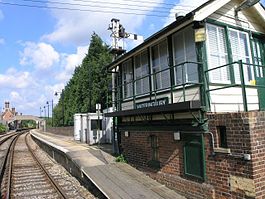Wateringbury railway station
| Wateringbury |
|
|---|---|
 |
|
| Location | |
| Place | Wateringbury |
| Local authority | Tonbridge and Malling |
| Coordinates | 51°14′57″N 0°25′21″E / 51.2493°N 0.4225°ECoordinates: 51°14′57″N 0°25′21″E / 51.2493°N 0.4225°E |
| Grid reference | TQ691528 |
| Operations | |
| Station code | WTR |
| Managed by | Southeastern |
| Number of platforms | 2 |
| DfT category | F2 |
| Live arrivals/departures, station information and onward connections from National Rail Enquiries |
|
| Annual rail passenger usage* | |
| 2011/12 |
|
| 2012/13 |
|
| 2013/14 |
|
| 2014/15 |
|
| 2015/16 |
|
| History | |
| Key dates | Opened 25 September 1844 |
| National Rail – UK railway stations | |
| * Annual estimated passenger usage based on sales of tickets in stated financial year(s) which end or originate at Wateringbury from Office of Rail and Road statistics. Methodology may vary year on year. | |
|
|
|
Wateringbury railway station is on the Medway Valley Line in Kent, England, and serves Wateringbury. Train services are provided by Southeastern. The station building, regarded as one of the finest Tudor-style stations in the country, was Grade II listed on 19 April 1985.
The APTIS-equipped ticket office in this building (on the northbound platform) closed in 1989; the building has remained disused for many years though in reasonable condition.
In 2007, a PERTIS (Permit to Travel) ticket machine was installed at the entrance to the northbound platform.
The signal box, which was Grade II listed in 2013 remains to control the level crossing gates.
The typical off-peak service from the station is one train per hour to Paddock Wood and Tonbridge, and one train an hour to Strood. Connections to London are available at either of these two stations, or by changing at Maidstone Barracks and walking to Maidstone East.
The station is mentioned in 'Hop Picking Diary' by George Orwell.
...
Wikipedia
